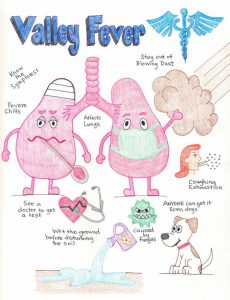- Slug: BC-CNS Valley Fever Masks, 395 words
- 1 photo and caption below.
- 1 video here, credit Julia Sandor.
By Victoria Hill and Julia Sandor
Cronkite News
PHOENIX – Arizona has recorded more than 6,800 cases of Valley fever so far this year, according to July data from the Arizona Department of Health Services. Cases have steadily climbed every year since 2016, with the state reporting more than 11,400 cases last year.
Valley fever is a lung disease caused by the inhalation of Coccidioides, a fungus common in the alkaline soil of the Sonoran Desert. Experts say it’s particularly important to take precautions during monsoon season, which puts more dust, dirt and bacteria into the air.
One way to protect yourself, doctors say, is by wearing something you likely already own: a mask.
“Wearing a mask, particularly an N95 mask, can also be a good way to prevent Valley fever,” said Dr. David Hatfield, chief medical officer at Hatfield Medical Group.
Two-thirds of the nation’s Valley fever cases are reported in Arizona, according to the state health department. In 2019, 18,407 cases of Valley fever were reported nationwide, most of them in Arizona and California, with the rest reported in Nevada, New Mexico, Utah and “other states,” according to the Centers for Disease Control and Prevention.
But those totals likely are an undercount: “Tens of thousands more illnesses likely occur and may be misdiagnosed because many patients are not tested for Valley fever,” the CDC said.
Hatfield said those most at risk for the disease include people who have had organ transplants, diabetics, those 60 or older and people who live in the Southwest – particularly Arizona.
Valley fever can be undiagnosed because it has symptoms similar to COVID-19 and the flu – cough, fever, exhaustion, according to the state health department. Valley fever symptoms usually are mild, and the infection can’t be passed to others.
Have a conversation with your health provider if “you are experiencing flu like symptoms that don’t seem to resolve over time,” said Dr. Brian Mochon, system medical director at Sonora Quest Laboratories.
To test for the noncontagious illness, professionals typically use a blood sample to look for the development of antibodies produced to fight the infection. Any primary care provider should be able to diagnose and treat Valley fever, according to the state health department.
However, the Valley Fever Center for Excellence has a list of Valley fever specialists. Tests for self-diagnoses also are available online.
For more stories from Cronkite News, visit cronkitenews.azpbs.org.
^__=
